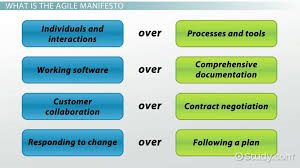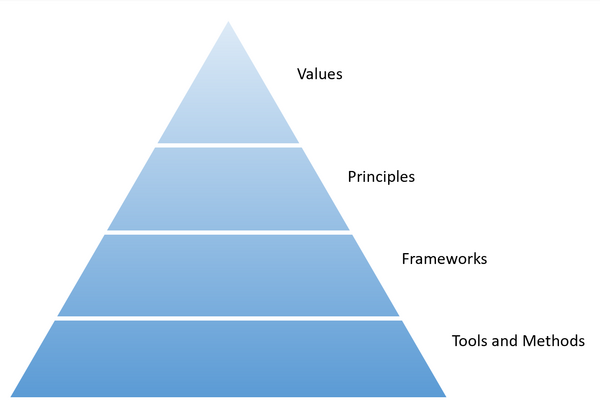Application of Agile
(→Introducing the Agile Project management Delivery Framework) |
(→Introducing the Agile Project management Delivery Framework) |
||
| Line 31: | Line 31: | ||
In the implementation of several of the principles, the Agile Project Management Framework is often used<ref name=''AOPQG''> ''ClydeBankBuisness/ Agile Project Management Quickstart guide, chapter 3'' </ref>, originalle proposed by Jim Highsmidt <ref name=''CIPp89''> ''Jim Highsmith/Creating Innovative Products p.89'' </ref> | In the implementation of several of the principles, the Agile Project Management Framework is often used<ref name=''AOPQG''> ''ClydeBankBuisness/ Agile Project Management Quickstart guide, chapter 3'' </ref>, originalle proposed by Jim Highsmidt <ref name=''CIPp89''> ''Jim Highsmith/Creating Innovative Products p.89'' </ref> | ||
| − | This Framework as seen in FIGUR has an iterative nature, and Agile in general is often described as incremental as of this. This framework has 5 phases; Envision, speculate, explore, adapt and close. These corresponds to the 5 phases of the Waterfall method <ref name=''AOPQG''> ''ClydeBankBuisness/ Agile Project Management Quickstart guide, chapter 2'' </ref>; Initiating, planning, Executing, Controlling and Closing. The framework relies on the use of sprints that is smaller time intervals focusing on building a specific feature of the end product. Ideally each sprint should result in a part of the end product, the feature that can be delivered, tested and create value for the costumer | + | This Framework as seen in FIGUR has an iterative nature, and Agile in general is often described as incremental as of this. This framework has 5 phases; Envision, speculate, explore, adapt and close. These corresponds to the 5 phases of the Waterfall method <ref name=''AOPQG''> ''ClydeBankBuisness/ Agile Project Management Quickstart guide, chapter 2'' </ref>; Initiating, planning, Executing, Controlling and Closing. The framework relies on the use of sprints that is smaller time intervals focusing on building a specific feature of the end product. Ideally each sprint should result in a part of the end product, the feature that can be delivered, tested and create value for the costumer<ref name=''CIPp89''</ref>. Though this is often interpreteted as Agile, it is noted than this is only a framework to practice Agile. As of this, projects not using this framework might also be labeled Agile. |
[[file:Pladsholder.png|600px]] | [[file:Pladsholder.png|600px]] | ||
Revision as of 16:37, 26 February 2019
Contents |
Abstract
This article decomposes Agile in order to make it clear what the prerequisites and gains from the use of Agile, and its different parts in a business. The Agile movement is all over and spreading widely and far from its origin in the software and IT sector, and its positive effects are reported extensively, there seems to be no stopping for agile. But originating from a software industry desiring to be more flexible, not every aspect of Agile is easy applicable in every business in various sectors eg. the construction sector has a whole different nature than the IT-development sector. Agile in its full form is covering various aspects as; way of structuring work, culture, management style etc. And while the use of iterative sprint increments can be opposed to the waterfall method, other parts as the management style is not opposed to the waterfall model. In this article Agile is decomposed into smaller parts by the use of the 12 principles of Agile. All of these parts of Agile is described in application, limits, gains and necessary setting for this to be applicable eg. limits due to the constraints of physicality. Lastly an overview model is presented highlighting the different aspects of Agile and their overlaps.This Article seeks to allow a business owners/consultants to analyze if Agile(or parts of Agile) is applicable to a business and rather throughout describe how to apply it.
Introduction
Agile is a way of doing project which has shown great results. Agile originates in the software industry, but has proven succesfull in other industries aswell. In the software development a success rate 28% bigger compared to projects based on a more classical project management approach[1].
Besides the success in Software Agile has spread far from this sector. Respondents to the yearly “State of Agile” report using Agile is from sectors as; Technology, Finans, Healthcare and onto Industrial/manufacturingwrite [2].
The advantages of Agile is reported to be extensive even in physical products. Some of the reported main advantages in physical product is “Increased transparency”, “increased internal learning”, “improved costumer understanding” but also onto very different parameters as “Shortened product development (Time-to-market)” and “Reduced risk for the product (eg. Technical feasibility, project failure)[3]. Note that these statements are from applying Agile to physical products.
Introducing Agile
In 2001 the present understanding of Agile originated with the Agile Manifest posted by 17 authors behind the Agile Alliance. The Manifest describes the fundamentals of Agile, in very broad formulations.[4] This version on Agile originated from the software industry that wanted more flexibility and felt limited by the classical way of managing projects.[5] Originating from these values are many ways of practicing agile. How to practically do Agile, will not be covered in this article, but it can serve as a great start to introduction to overall concept, the fundamentals needed in order to maintain overview when later choosing framework.
From the 4 values the 12 principles of Agile is created, outlining a bit more how to do Agile[5]. The principples cover the same, only the detail level and contretness differs, the main part of this article will take ins ofsrping in the 12 principles.
Further detailed than the principples is found in the Frameworkes used to practice Agile, famous ones to be mentioned could be; Scrum, Kanban, XP, ect. These all provid tools and practical ways of applying the principles of Agile. Some frameworks focus more on some parts of Agile some applying all and yet some only applying fewer. These Framework for different sectors and industries. The different frameworks of Agile might differ a lot from the values and principples on some points, though being somehow based on these. Agile is not just the these famouse frameworks but a whole umbrella of different ideas based on the same idea[5] . Nor is there a simple formula and easy steps, that will ensure succes[6]
There are many understandings of being Agile, practicing Agile or doing Agile. It is here noted that it is very possible to integrate some parts of Agile without the others. Also it is noted that one should be very carful then describing how practicing Agile or stating to be Agile, this can be interpreted on many ways by the receiver.
Introducing the Agile Project management Delivery Framework
In the implementation of several of the principles, the Agile Project Management Framework is often used[7], originalle proposed by Jim Highsmidt [8] This Framework as seen in FIGUR has an iterative nature, and Agile in general is often described as incremental as of this. This framework has 5 phases; Envision, speculate, explore, adapt and close. These corresponds to the 5 phases of the Waterfall method [9]; Initiating, planning, Executing, Controlling and Closing. The framework relies on the use of sprints that is smaller time intervals focusing on building a specific feature of the end product. Ideally each sprint should result in a part of the end product, the feature that can be delivered, tested and create value for the costumer[10]
Cite error:
<ref> tags exist, but no <references/> tag was found

